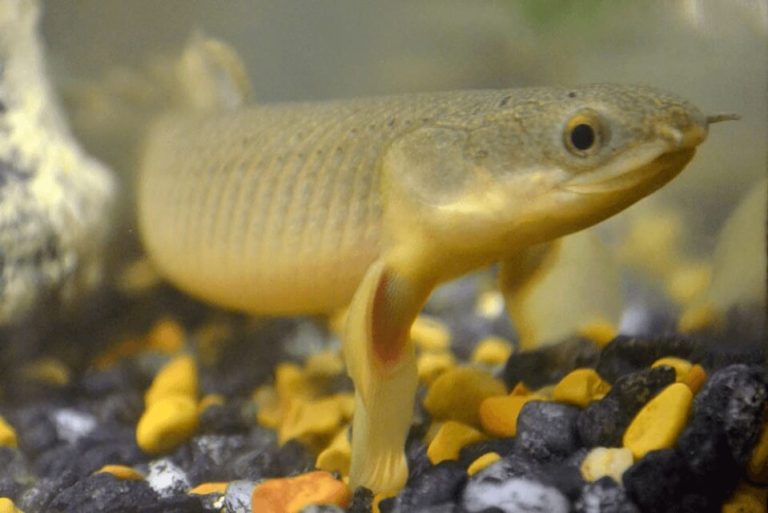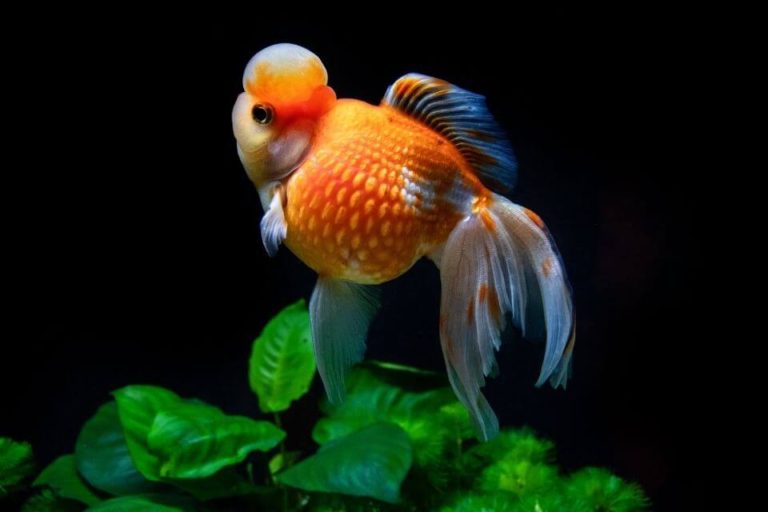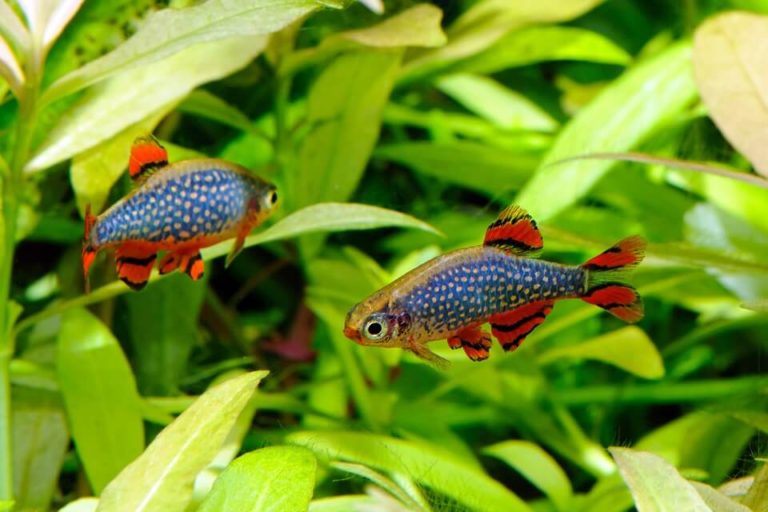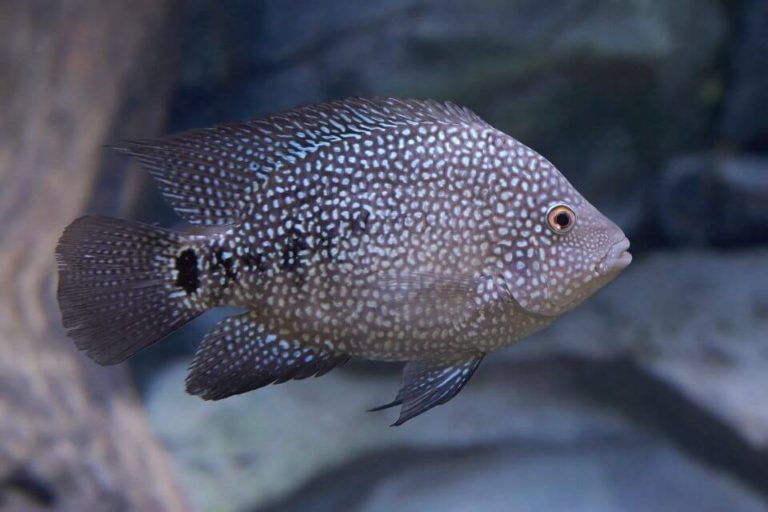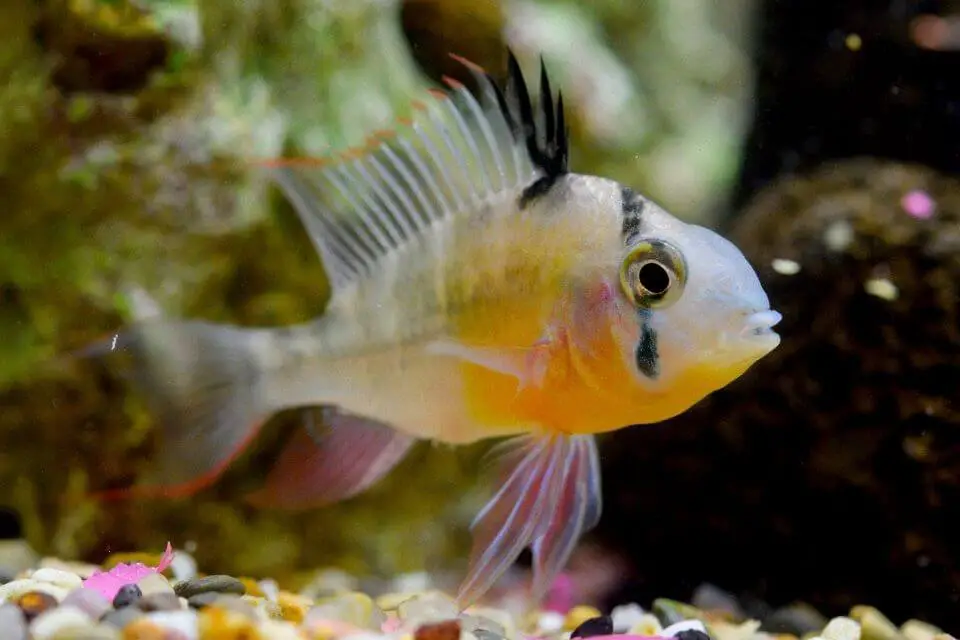Peacock Cichlid Care Guide: Diet, Tankmates, Breeding and More
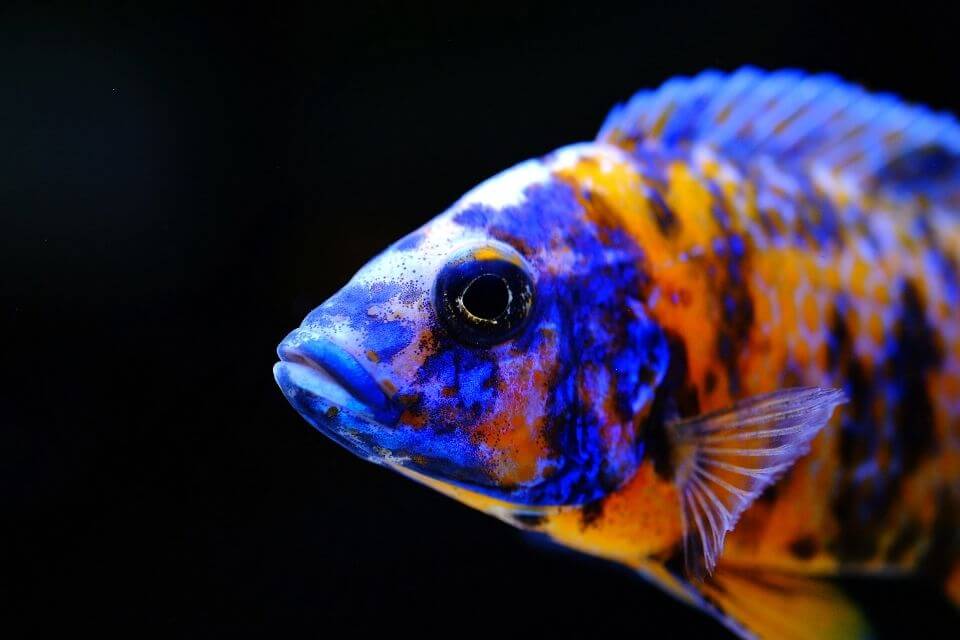
Whether you are a novice or seasoned aquarist, selecting the fish to keep in your tank is not always easy. However, as your number one resource for fish care information, we do deep research about various kinds of fish species and bring you unrivaled guides for fish species that we know will brighten up your tank fish-keeping experience.
In this post, we are happy to take you through the crucial care details of the beautiful and irresistible Peacock Cichlid fish species.
To enjoy the beauty that this fish brings, especially in indoor tanks, you should be ready to learn what keeping it calls for. The wonderful colors of the Peacock Cichlids are just one of the factors that make it rise above the rest.
Read this guide to the end to know why this fish deserves it all and why you should not at least miss one in your aquarium.
| Quick Facts: | |
|---|---|
| Common Names | : Aulonocaras or Peacocks fish |
| Scientific Name | : Aulonocara nyassae |
| Family | : Cichlidae |
| Origin | : Lake Malawi, Africa |
| Care Level | : Easy |
| Lifespan | : 6 - 8 years |
| Size (average) | : 4 - 6 inches long |
| Diet | : Omnivores |
| Breeding | : Egglayer |
| Social | : Territorial |
| Temperament | : Semi-aggressive |
| Minimum Tank Size | : 50 - 55 gallons |
| Temperature | : 74 - 82 °F (23 – 28 °C) |
| Water Hardness | : 4 - 6 dGH |
| Water pH Level | : 7.5 - 8.5 |
Overview of Peacock Cichlid
The Peacock Cichlid is a stunning brightly colored medium-sized freshwater fish species and common addition to many modern fish tanks. Both the males and the females exhibit bright colors and iridescent shades that are interesting to look at.
It belongs to the Cichlidae family that covers all other known Cichlids and Genus Aulonocara. They also commonly know as Aulonocaras or Peacocks fish that is scientifically known as Aulonocara nyassae. Aulonocarasis a semi-aggressive fish species that are Omnivores and are bottom active swimmers.
These fish species need moderate care and have a life expectancy of up to 8 years. Even these fish shows semi-aggressive behavior they are known as excellent community fish by the fish keepers.
This fish is very rewarding when it comes to vibrancy and brightness. It is one of the most charming and beautiful-looking fish you will find in today’s tank fish market.
Origin, Distribution, and Availability
Peacock Cichlids are native to Lake Malawi, one of the Southern Rift Valley lakes in Africa. These fish prefer the shallow water bodies and the shores of this hard water lake. Since this lake’s water has very many dissolved minerals, the Peacock Cichlids have adapted to living in conditions of neutral to high pH water conditions.
In the wild environments, the Peacock Cichlid enjoys living in rocky areas or any other place where they can exhibit their territorial behaviors. Although these fish would also prefer environments with a decent growth of plants that they can play with and devour, their lake habitats cannot support this. There are countless highly aggressive and destructive fish that will get rid of any plant that attempts to grow in these habitats.
The Peacock Cichlid is one of the most brightly colored fish in the world, was quite easy to enter the tank fish market. Through rigorous breeding, the fish is now able to survive in many parts of the world and is a must-have fish for pet stores worldwide.
Also, you can buy these fish species online from some reputed suppliers.
Peacock Cichlid Typical Behavior
While most Cichlids are known for being aggressive, the Peacock Cichlids are relatively calm and peaceful. When put in a community of compatible fish (discussed in the tank mates section), the Peacock Cichlids will live peacefully with the other fish. Considering that these fish exhibit territorial behaviors, they will also live excellently independently.
In the wild, Peacock Cichlids will hunt for food in the sand. They are quite alert and will detect any movement from an invertebrate they can snack on. They exhibit the same behavior in Aquariums, where they like to eat their food from the substrate. If you would want to keep Peacock Cichlids happy and satisfied, always include sand in their tank substrate.
In the tank conditions, the Peacock Cichlid will prefer to swim at the bottom section. This fish is an active swimmer and, when added to an indoor space, will at all times brighten it.
Characteristics of Peacock Cichlid
Appearance
The Peacock Cichlid is one of the most colorful fish you will ever find in the tank fish market. Even if you are not used to tank fish keeping, the first glance at this fish will surely win your heart and ‘lure’ you into aquarium fish keeping. Even if any other aspect that makes this fish a perfect Aquarium fish was absent, its appearance would still make it stand out.
The Peacock Cichlid is a medium-sized fish with an oversized lateral system. Even with their long bodies, they are still fairly thick, especially when they reach adulthood. Note that even if there are many Peacock Cichlid varieties, the body shape and size are just the same and primarily, colors and special markings are the features that differentiate them.
The Peacock Cichlid has a distinct fins system that adds to its uniqueness. First, their dorsal and anal fins are very prominent, featuring trailing edges where nicely elongated rays emanate. The anal fins are, however, shorter than the dorsal fins. The tail fin is fan-shaped and has fairly rounded edges.

Colors and Special Markings
The base colors for this fish are blue, yellow, gold, and orange. The males are more brightly colored than the females. These colors vary from one Peacock Cichlid variety to another.
These are the main types of Peacock Cichlids and their special markings:
- Aulonocara Nyassae (Emperor Cichlid): The main color is blue with a metallic highlight. Special markings are red patches along the belly area and behind the gills.
- Aulonocara Baenschi (Nkhomo-benga-peacock): Its primary color is bright yellow and blue on the head area. They have a long nose, a feature that makes them unique from other Peacock Cichlids.
- Aulonocara Multicolor: The base color is orange for this Peacock Cichlid variety. Its special markings are in form of yellow, red, blue, and black spots all over their body.
- Aulonocara Maylandi (Siphurhead Peacock): This Peacock Cichlid has a blue theme with a metallic highlight. Its special markings are stripes of yellow that run from the head to the dorsal fins.
- Aulonacara Jacobfreibergi (Fairy Cichlids): The main color is yellow and blue on the head area. Special markings are dark and blue stripes along on their belly and head areas. The dorsal fins also have a distinctive wide blue stripe.
- Aulonocara Stuartgranti (Flavescent Peacock): Exhibits color morphs, with the alternating colors being bright yellow and blue.
- Aulonocara Maulana: It is a metallic blue-colored Peacock Cichlid fish variety with a yellow stripe behind the gills as the distinctive marking.
- Aulonocara Red Ruby: This is one of the Peacock Cichlid’s artificial variants, meaning that there are no traces of it in the natural habitats. Their main colors are vivid red and blue. The markings are pink stripes on the dorsal and tail fins.
- OB Peacocks: These are also human-made Peacock Cichlids that comes with a mix of the theme Peacock Cichlid colors.
Size: How Big Do Peacock Cichlid Get?
A fully grown Peacock Cichlid can grow up to 4 to 6 inches in length. Note that this depends on how well you look after the fish. Also, the size depends on their variation. There are many Peacock Cichlid variation exists.
Lifespan
When given proper care, a Peacock Cichlid will live for around 6 to 8 years under optimal tank conditions.
Aquarium Care and Conditions for Peacock Cichlid
Peacock Cichlids do not demand out-of-the-box care conditions but still need to be well looked after to enjoy their benefits. The most crucial point that you need to always keep in mind is that Peacock Cichlids are territorial and that the last thing they want is a confined and restrictive living space.
Below is a more detailed explanation of what keeping Peacock Cichlids calls for.
Tank Conditions and Care
The tank should be large enough to accommodate several Peacock Cichlids as even though they lead territorial life, they also swim and bottom feed together in schools, especially during the breeding season.
Since Peacock Cichlids are excellent swimmers, they would also perform better in taller tanks. Let’s explore specific tank conditions needed for the Peacock Cichlid.
Peacock Cichlid Tank Size
The minimum tank size for a group of 4 to 6 Peacock Cichlids is 50 gallons. The recommended perfect tank size for this group of Peacock Cichlids is 100 gallons because they are very active swimmers. You can also do your calculations on the ½ inch per gallon basis to know what tank size you need.
Especially when you have a large group to rear. If you wish to keep Peacock Cichlids with other tank fish, then you need to invest in a large community fish tank that factors in the space requirements of every fish species it holds.
Tank Setup

On finding a perfect tank size for your Peacock Cichlids, you need to proceed to set it up. Here you need to follow some recommendations for the substrate, lighting, and decorations. Let’s explore each of these factors and discuss what the Peacock Cichlids require.
Let’s start with the substrate where you need to mimic what is in their natural habitat- mineral leaching sand. Aragonite sand is the recommended Peacock Cichlid substrate as it releases CaCO3 into the tank water maintaining the required water hardness and water acidity (pH) levels.
This substrate is also perfect for the Peacock Cichlids as they like to dig and move sand around, not to mention that they prefer feeding on the bottom.
In terms of lighting, the Peacock Cichlids have no specific lighting requirements and will do well in a wide range of lighting conditions. Just go for the lighting that will favor the other fish species in the tank or what is readily available to you.
Even with this freedom, do not settle for extremes, i.e., too bright or too dull light.
In the wild, there are lots of rocks and driftwood that the Peacock Cichlid enjoy as hiding places. This can be emulated in a Peacock Cichlid tank to trick these fish that they are in their natural habitat. You can even arrange rocks to form cave-like structures in their tank.
Plants can also be added to the tank as decoration and as a material for the fish to establish territories from. Peacock Cichlids are active swimmers and you would want to keep the decoration in the tank to the sides or the bottom.
Suitable Plants
Peacock Cichlids have minimal plant options due to their vigorous appetite for most standard live tank plants. Some plants such as Java fern, Anacharis, and Duckweed will, however, survive in a Peacock Cichlids tank. The perfect solution for Peacock Cichlid is artificial plants that are not easy to devour.
Expert's Advice: Using live plants in your aquarium is optional, and you can use artificial plastic plants. But unlike plastic plants, live plants maintain the water freshness by adding oxygen, utilizing nitrates, and removing carbon dioxide from the water. Hence the live aquarium plants are recommended.
Water Condition and Parameters
The tropical climate of Lake Malawi means that the Peacock Cichlid is adapted to live in warm waters. It is recommended to keep the tank water temperature between 74 to 82 °F (23 to 28 degrees Celsius).
You can use an aquarium heater to keep this temperature in a steady condition.
The Peacock Cichlid produces highly nitrogenous waste, meaning that you need to invest in a filter that can keep up with the waste. Here, a canister filter is recommended as it has enough bio-media to deal with the waste that the fish produces, maintaining the required water quality at all times for the fish to enjoy.
As mentioned above, the Peacock Cichlid’s wild habitats have very hard water that is infused with lots of minerals. This means that these fish are adapted to the water of high hardness and pH.
In-tank conditions, you need to ensure that the water pH is 7.5 to 8.5 and hardness be around 4 to 6 dGH to simulate the natural habitat’s conditions.
- Water Temperature: 74 – 82 °F (23 – 28 °C)
- Water Acidity: 7.5 – 8.5 pH
- Water Hardness: 4 – 6 dGH
Diet: What Do Peacock Cichlid Eat?
Peacock Cichlids are omnivores and will do well with a wide variety of foods. People who have kept this fish species in Aquarium recommend well-balanced Cichlid pellets as the best food to feed these fish. You can supplement this with frozen brine shrimp, bloodworms, and Fluval bug bites.
Common Diseases of Peacock Cichlid
The Peacock Cichlid is a hardy fish but will suffer from the following diseases if the food and tank conditions are compromised:
- Ich
- Malawi bloat
- Swim bladder disease
- Hexamita
- Fish Tuberculosis
These diseases’ common symptoms are lack of appetite, total isolation, sunken belly, white fecal matter, and fast breathing. Reach out to a fish veterinarian anytime you notice strange behavior/body changes with your Peacock Cichlid.

Peacock Cichlid Breeding
Breeding Peacock Cichlid is not that much complicated and you can do it at home by following some guidelines. First, you must understand that the Peacock Cichlids are territorial (although non-aggressive) and will generally live solely and independently.
However, this behavior is overturned during breeding and the fish ready for spawning spend most of their time together. If you observe such behavior, then it’s time to move the fish to a separate breeding tank and follow the following for successful breeding:
- Put the fish in a reasonable breeding group. The general rule is 1 male for 3 or 4 females.
- Raise the water temperature around 80 degrees Fahrenheit (27 °C) or 1 to 2 degrees more than the current temperature. This will initiate spawning that preferably occurs in warm water.
- Provide hideouts such as rock caves or shelter in the form of tank plants. The hideouts will be perfect for the Peacock Cichlid to start courting and the places where the females will lay their eggs.
On fulfilling these three conditions, you can now leave the rest of the work to the Peacock Cichlids. The following are likely to happen during the breeding process of the Peacock Cichlids:
The female will lay the eggs (around 10 if it is the first time or averagely 30 for females who have been pregnant before) to be fertilized by the males. Female Peacock Cichlids are mouth breeders meaning they will keep the eggs in their mouth to protect them as they grow.
After 2 to 4 weeks of this form of incubation, the eggs will hatch and the fry emerge. The female will take the initiative of looking after the baby fish until they can survive on themselves. A week is enough for the small ones to live independently.
Frequently Asked Questions
There are few common questions you may have about the Peacock Cichlids that we answered below. We hope it will help on your way. If you have more questions that we did not discuss here, do not forget to mention them in the comment section at the end of this article.
How Can You Tell If a Peacock Cichlid is Male or Female?
It is relatively easy to determine the gender difference of Peacock Cichlid as the male and female species have several physical differences. Here are three straight forward factors that you can check when you want to recognize if a Peacock Cichlid is male or female:
-Behavior During the Breeding Period
Male Peacock Cichlids are quite aggressive during this season, showing behaviors that are meant to impress the females. You will, during this period, find the males busy building and securing a place for reproduction- they will primarily build caves or nests.
The females are the exact opposite as they will generally look calm throughout this whole period. They will spend their time with any other fish preparing to spawn and ignore the rest of the Cichlids that may be in the tank. Even with this, they are still protective and it is not a wonder to see a female carrying her eggs in the mouth for this purpose.
-Body Size and Shape
The males are generally bigger than the females and you can even find some that are even an inch longer than their female counterparts. Their fins (dorsal, caudal, and anal) are also larger than those of the females.
-Colors and Special Markings
The colors and marking are the most distinctive feature between a male and a female Peacock Cichlid. Just like many ornamental tank fish, the male Peacock Cichlids are more vibrant and colorful and will have more special markings than the females.
During the breeding season, these differences are even more distinct. The males may also have a special marking called egg spots on the anal fins. These special markings will help to find a mate easily.
How Long Does It Take for A Peacock Cichlid to Color Up?
Peacock Cichlids will take around 2 years to color up or develop their full stunning colors and special markings. The males will generally color up faster than the females and thus, this is also a consideration that you need to keep in mind when bringing in your first lot.
How Many Peacock Cichlids Should I Get for A Tank?
This depends on the size of the tank you have. For 50 gallons tanks, keep a single group; 4 to 6 Peacock Cichlids. The most important consideration here is the ‘polygamous’ rule that recommends keeping one male Peacock Cichlid with 3-4 females per group.
What Fish Can Live with Peacock Cichlids?
This fish species will live harmoniously with the following as tank mates:
- Botia Loach
- African Red Eye Tetra
- Redtail Shark
- Rainbow Shark
- Synodontis Catfish
Can Peacock Cichlids Live with African Cichlids?
African Cichlids are known for being highly aggressive and hence you have to be very careful when bringing in an African Cichlid in a community tank with Peacock Cichlids. Please ensure that the African Cichlids you are bringing in are non-aggressive variants and of similar size and temperament as your Peacock Cichlids.
Are Peacock Cichlids Hardy?
Peacock Cichlids are very hardy, easy to maintain, and docile. This is, of course, the main reason why novice Cichlids keepers prefer this fish. Even with this, you need to maintain the required tank conditions and fulfill their straightforward feeding needs to keep them healthy.
Are Peacock Cichlids Aggressive?
Peacock Cichlids are extremely laid back and exhibit very little aggression. They can only get a little aggressive if they feel threatened and disturbed by notorious tank mates. However, they will barely attack their tank mates.
Do Peacock Cichlids Have Teeth?
Yes, all Cichlids have teeth. For the Peacock Cichlids, the teeth are for hunting purposes only and again slightly vary in terms of shape and size from one Peacock Cichlids variety to another. In very rare cases will the Peacock Cichlid even try to bite your fingers.
Final Thoughts
On reading this, you can tell that one thing stands out about the Peacock Cichlid- it is the most beautiful, peaceful, and easy to maintain among all Cichlids. This, in addition to its entertaining personality, makes it the perfect ornamental fish to add to your Aquarium.
Just ensure that the Aquarium is large enough to cater to their heightened swimming needs.
We recommend this fish for both novice and seasoned tank fish keepers looking for an amazing fish that will not stress them out. If you like to keep your fish in a community tank, then you can go for a few Peacock Cichlids males and absolutely any non-aggressive tank fish that you may have.
Finally, don’t forget that a Peacock Cichlid will only reward you when you look after it in the right way.



